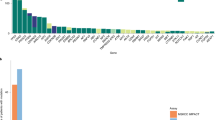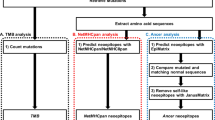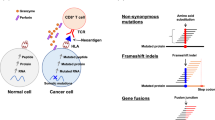Abstract
Cancer-associated gene fusions are a potential source for highly immunogenic neoantigens, but the lack of computational tools for accurate, sensitive identification of personal gene fusions has limited their targeting in personalized cancer immunotherapy. Here we present EasyFuse, a machine learning computational pipeline for detecting cancer-specific gene fusions in transcriptome data obtained from human cancer samples. EasyFuse predicts personal gene fusions with high precision and sensitivity, outperforming previously described tools. By testing immunogenicity with autologous blood lymphocytes from patients with cancer, we detected pre-established CD4+ and CD8+ T cell responses for 10 of 21 (48%) and for 1 of 30 (3%) identified gene fusions, respectively. The high frequency of T cell responses detected in patients with cancer supports the relevance of individual gene fusions as neoantigens that might be targeted in personalized immunotherapies, especially for tumors with low mutation burden.
This is a preview of subscription content, access via your institution
Access options
Access Nature and 54 other Nature Portfolio journals
Get Nature+, our best-value online-access subscription
$29.99 / 30 days
cancel any time
Subscribe to this journal
Receive 12 print issues and online access
$209.00 per year
only $17.42 per issue
Buy this article
- Purchase on Springer Link
- Instant access to full article PDF
Prices may be subject to local taxes which are calculated during checkout





Similar content being viewed by others
Data availability
Sequence data from this study have been deposited in the Sequence Read Archive (SRA accession, used in Figs. 1, 2 and 3; NCBI BioProject ID PRJNA764684, used in Fig. 2) or the European Genome-phenome Archive (EGA accession EGAS00001004877, used in Figs. 4 and 5). Previously published sequencing data (immunogenicity cohort, Fig. 5, samples 10–14) are available in the EGA (EGA accession EGAD00001004455). Previously sequenced cell line data used in Fig. 1 are available at SRA accession PRJNA543964. Raw predicted GFs for all samples are available on Figshare (https://doi.org/10.6084/m9.figshare.19087049). Source data are provided with this paper.
Code availability
The source code and documentation of EasyFuse is available at GitHub (https://github.com/TRON-Bioinformatics/easyfuse).
References
Gao, Q. et al. Driver fusions and their implications in the development and treatment of human cancers. Cell Rep. 23, 227–238 (2018).
Shtivelman, E., Lifshitz, B., Gale, R. P. & Canaani, E. Fused transcript of abl and bcr genes in chronic myelogenous leukaemia. Nature 315, 550–554 (1985).
Amatu, A., Sartore-Bianchi, A. & Siena, S. NTRK gene fusions as novel targets of cancer therapy across multiple tumour types. ESMO Open 1, e000023 (2016).
Sahin, U. & Türeci, Ö. Personalized vaccines for cancer immunotherapy. Science 359, 1355–1360 (2018).
Carreno, B. M. et al. Cancer immunotherapy. A dendritic cell vaccine increases the breadth and diversity of melanoma neoantigen-specific T cells. Science 348, 803–808 (2015).
Ott, P. A. et al. An immunogenic personal neoantigen vaccine for patients with melanoma. Nature 547, 217–221 (2017).
Garraway, L. A. & Lander, E. S. Lessons from the cancer genome. Cell 153, 17–37 (2013).
Chang, M. T. et al. Identifying recurrent mutations in cancer reveals widespread lineage diversity and mutational specificity. Nat. Biotechnol. 34, 155–163 (2016).
Bosch, G. J., Joosten, A. M., Kessler, J. H., Melief, C. J. & Leeksma, O. C. Recognition of BCR-ABL positive leukemic blasts by human CD4+ T cells elicited by primary in vitro immunization with a BCR-ABL breakpoint peptide. Blood 88, 3522–3527 (1996).
Yang, W. et al. Immunogenic neoantigens derived from gene fusions stimulate T cell responses. Nat. Med. 25, 767–775 (2019).
Haas, B. J. et al. Accuracy assessment of fusion transcript detection via read-mapping and de novo fusion transcript assembly-based methods. Genome Biol. 20, 213 (2019).
Kosugi, S. et al. Comprehensive evaluation of structural variation detection algorithms for whole genome sequencing. Genome Biol. 20, 117 (2019).
Zhou, J. X. et al. Identification of KANSARL as the first cancer predisposition fusion gene specific to the population of European ancestry origin. Oncotarget 8, 50594–50607 (2017).
Pintarelli, G. et al. Read-through transcripts in normal human lung parenchyma are down-regulated in lung adenocarcinoma. Oncotarget 7, 27889–27898 (2016).
Babiceanu, M. et al. Recurrent chimeric fusion RNAs in non-cancer tissues and cells. Nucleic Acids Res. 44, 2859–2872 (2016).
Sorn, P., Hohlsträter, C., Löwer, M., Sahin, U. & Weber, D. ArtiFuse—computational validation of fusion gene detection tools without relying on simulated reads. Bioinformatics 36, 373–379 (2019).
Asmann, Y. W. et al. A novel bioinformatics pipeline for identification and characterization of fusion transcripts in breast cancer and normal cell lines. Nucleic Acids Res. 39, e100 (2011).
Edgren, H. et al. Identification of fusion genes in breast cancer by paired-end RNA-sequencing. Genome Biol. 12, R6 (2011).
Kangaspeska, S. et al. Reanalysis of RNA-sequencing data reveals several additional fusion genes with multiple isoforms. PLoS ONE 7, e48745 (2012).
Maher, C. A. et al. Transcriptome sequencing to detect gene fusions in cancer. Nature 458, 97–101 (2009).
Sakarya, O. et al. RNA-seq mapping and detection of gene fusions with a suffix array algorithm. PLoS Comput. Biol. 8, e1002464 (2012).
Nicorici, D. et al. FusionCatcher—a tool for finding somatic fusion genes in paired-end RNA-sequencing data. Preprint at https://www.biorxiv.org/content/10.1101/011650v1 (2014).
Wang, K. et al. MapSplice: accurate mapping of RNA-seq reads for splice junction discovery. Nucleic Acids Res. 38, e178 (2010).
Jia, W. et al. SOAPfuse: an algorithm for identifying fusion transcripts from paired-end RNA-seq data. Genome Biol. 14, R12 (2013).
Okonechnikov, K. et al. InFusion: advancing discovery of fusion genes and chimeric transcripts from deep RNA-sequencing data. PLoS ONE 11, e0167417 (2016).
Uhrig, S. et al. Accurate and efficient detection of gene fusions from RNA sequencing data. Genome Res. 31, 448–460 (2021).
ICGC/TCGA Pan-Cancer Analysis of Whole Genomes Consortium. Pan-cancer analysis of whole genomes. Nature 578, 82–93 (2020).
Leng, Q., Tarbe, M., Long, Q. & Wang, F. Pre-existing heterologous T-cell immunity and neoantigen immunogenicity. Clin. Transl. Immunology 9, e01111 (2020).
Heyer, E. E. et al. Diagnosis of fusion genes using targeted RNA sequencing. Nat. Commun. 10, 1388 (2019).
Creason, A. et al. A community challenge to evaluate RNA-seq, fusion detection, and isoform quantification methods for cancer discovery. Cell Syst 12, 827–838 (2021).
Buzyn, A. et al. Peptides derived from the whole sequence of BCR-ABL bind to several class I molecules allowing specific induction of human cytotoxic T lymphocytes. Eur. J. Immunol. 27, 2066–2072 (1997).
Gambacorti-Passerini, C. et al. Human CD4 lymphocytes specifically recognize a peptide representing the fusion region of the hybrid protein pml/RARa present in acute promyelocytic leukemia cells. Blood 81, 1369–1375 (1993).
Makita, M. et al. Leukemia-associated fusion proteins, dek-can and bcr-abl, represent immunogenic HLA-DR-restricted epitopes recognized by fusion peptide-specific CD4+ T lymphocytes. Leukemia 16, 2400–2407 (2002).
Sato, Y. et al. Detection and induction of CTLs specific for SYT-SSX-derived peptides in HLA-A24+ patients with synovial sarcoma. J. Immunol.169, 1611–1618 (2002).
van den Broeke, L. T., Pendleton, C. D., Mackall, C., Helman, L. J. & Berzofsky, J. A. Identification and epitope enhancement of a PAX-FKHR fusion protein breakpoint epitope in alveolar rhabdomyosarcoma cells created by a tumorigenic chromosomal translocation inducing CTL capable of lysing human tumors. Cancer Res. 66, 1818–1823 (2006).
Sahin, U. et al. Personalized RNA mutanome vaccines mobilize poly-specific therapeutic immunity against cancer. Nature 547, 222–226 (2017).
Richman, L. P., Vonderheide, R. H. & Rech, A. J. Neoantigen dissimilarity to the self-proteome predicts immunogenicity and response to immune checkpoint blockade. Cell Syst. 9, 375–382 (2019).
Bjerregaard, A.-M. et al. An analysis of natural T cell responses to predicted tumor neoepitopes. Front. Immunol. 8, 1566 (2017).
Strønen, E. et al. Targeting of cancer neoantigens with donor-derived T cell receptor repertoires. Science 352, 1337–1341 (2016).
Balachandran, V. P. et al. Identification of unique neoantigen qualities in long-term survivors of pancreatic cancer. Nature 551, 512–516 (2017).
Bessell, C. A. et al. Commensal bacteria stimulate antitumor responses via T cell cross-reactivity. JCI Insight 5, e135597 (2020).
Nelson, R. W. et al. T cell receptor cross-reactivity between similar foreign and self peptides influences naive cell population size and autoimmunity. Immunity 42, 95–107 (2015).
Robinson, D. R. et al. Functionally recurrent rearrangements of the MAST kinase and Notch gene families in breast cancer. Nat. Med. 17, 1646–1651 (2011).
Dobin, A. et al. STAR: ultrafast universal RNA-seq aligner. Bioinformatics 29, 15–21 (2013).
Haas, B. J. et al. STAR-Fusion: fast and accurate fusion transcript detection from RNA-seq. Preprint at https://www.biorxiv.org/content/10.1101/120295v1 (2017).
Kent, W. J. BLAT—the BLAST-like alignment tool. Genome Res. 12, 656–664 (2002).
Untergasser, A. et al. Primer3—new capabilities and interfaces. Nucleic Acids Res. 40, e115 (2012).
Koressaar, T. & Remm, M. Enhancements and modifications of primer design program Primer3. Bioinformatics 23, 1289–1291 (2007).
Liaw, A. & Wiener, M. Classification and regression by randomForest. R News 2, 18–22 (2002).
Boegel, S. et al. HLA typing from RNA-seq sequence reads. Genome Med. 4, 102 (2012).
Jurtz, V. et al. NetMHCpan-4.0: improved peptide–MHC class I interaction predictions integrating eluted ligand and peptide binding affinity data. J. Immunol. 199, 3360–3368 (2017).
Jensen, K. K. et al. Improved methods for predicting peptide binding affinity to MHC class II molecules. Immunology 154, 394–406 (2018).
Holtkamp, S. et al. Modification of antigen-encoding RNA increases stability, translational efficacy, and T-cell stimulatory capacity of dendritic cells. Blood 108, 4009–4017 (2006).
Dauer, M. et al. Mature dendritic cells derived from human monocytes within 48 hours: a novel strategy for dendritic cell differentiation from blood precursors. J. Immunol. 170, 4069–4076 (2003).
Acknowledgements
We thank the multicentre phase I study NCT02035956 and the RB_T002 research program (DRKS-ID: DRKS00011790) patients, from whom analyzed samples were obtained, and we thank the involved study site teams for their support and collaboration. We thank K. Chu and C. Büchner for proofreading and assistance with the manuscript. We thank O. Akilli-Oeztuerk for support with biosampling, R. Siek for support with installation of tools and setup on our servers and C. Ritzel for testing of EasyFuse pipeline and Docker image. Furthermore, we thank S. G. Maurici for technical support with RT–qPCR analysis and A. Henrich, S. Burchard and P. D. Dinh for technical support with the RNA sequencing. This work was supported by a European Research Council Advanced Grant to U.S. (ERC-AdG 789256).
Author information
Authors and Affiliations
Contributions
U.S. conceptualized the work and strategy. D.W., J.I., M.S. and I.V. planned and analyzed experiments. K.S. and M.S. performed the experiments. D.W., J.I., P.S., C.H., U.L., B.S., F.L. and M.L. performed data analysis. D.W., J.I. and U.S. interpreted data and wrote the manuscript.
Corresponding author
Ethics declarations
Competing interests
U.S. is a board member and employee of BioNTech SE. U.L., K.S. and I.V. are employees of BioNTech SE. U.S. is chief executive officer and stock owner of BioNTech SE. U.S., K.S. and I.V. have securities in BioNTech SE. The remaining authors declare no competing interests.
Peer review
Peer review information
Nature Biotechnology thanks Daniel Wells, Malachi Griffith and the other, anonymous, reviewer(s) for their contribution to the peer review of this work.
Additional information
Publisher’s note Springer Nature remains neutral with regard to jurisdictional claims in published maps and institutional affiliations.
Supplementary information
Supplementary Information
Supplementary Figs. 1–10 and associated legends
Supplementary Table
Supplementary Tables 1–8 and associated legends
Source data
Source Data Fig. 5e
Unprocessed raw image compilation of ELISpot plates. The example shown in 5e is presented in columns 10/11 for CD4.
Source Data Fig. 5e
Unprocessed raw image compilation of ELISpot plates. The example shown in 5e is presented in columns 10/11 for CD8.
Rights and permissions
About this article
Cite this article
Weber, D., Ibn-Salem, J., Sorn, P. et al. Accurate detection of tumor-specific gene fusions reveals strongly immunogenic personal neo-antigens. Nat Biotechnol 40, 1276–1284 (2022). https://doi.org/10.1038/s41587-022-01247-9
Received:
Accepted:
Published:
Issue Date:
DOI: https://doi.org/10.1038/s41587-022-01247-9
This article is cited by
-
Informing immunotherapy with multi-omics driven machine learning
npj Digital Medicine (2024)
-
The artificial intelligence and machine learning in lung cancer immunotherapy
Journal of Hematology & Oncology (2023)
-
Redefining serological diagnostics with immunoaffinity proteomics
Clinical Proteomics (2023)
-
Antigen presentation in cancer — mechanisms and clinical implications for immunotherapy
Nature Reviews Clinical Oncology (2023)
-
Personalized RNA neoantigen vaccines stimulate T cells in pancreatic cancer
Nature (2023)



